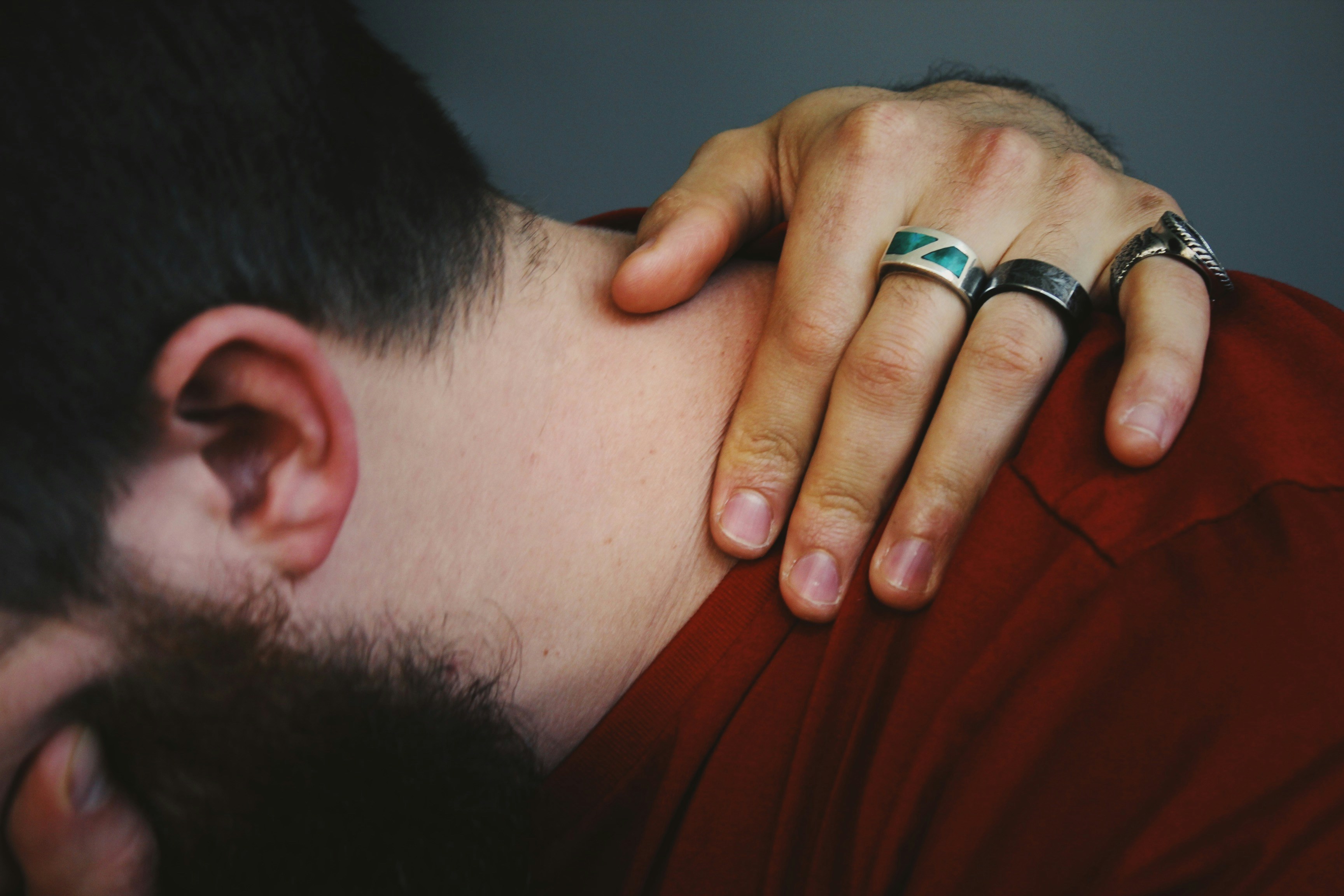Ever notice your tinnitus get louder after a stressful day, a long laptop session, or a night of jaw clenching? You’re not imagining it. For many people, the muscles and joints around the jaw and neck can “talk” to the auditory system. The good news: everyday habits can help you turn the volume down.
Meet Somatic Tinnitus: When Body Signals Nudge Your Ears
Tinnitus is the perception of sound without an external source—often a ring, hiss, or buzz. In somatic (or somatosensory) tinnitus, signals from muscles, joints, and nerves in the head and neck region can influence that sound. The trigeminal nerve (jaw/face), cervical nerves (neck), and the auditory pathways have cross-talk. When tension is high—think tight jaw, forward head posture, shoulder shrugging, or clenching—those signals can modulate tinnitus loudness or pitch.
Key idea: somatic tinnitus doesn’t mean your ears aren’t involved. It means your body may be adding a “gain knob.” Addressing tension doesn’t cure all tinnitus, but it often lowers the baseline and reduces spikes.
A 60-Second Self-Check: Is There a Somatic Component?
Try this gentle experiment. Stop if anything hurts.
- Open and close your mouth slowly. Does the tinnitus change in loudness or pitch?
- Gently clench your teeth for 2 seconds, then relax. Any change?
- Turn your head left and right; tip your ear toward each shoulder. Notice shifts?
- Press the jaw muscles just in front of your ears (near the TMJ) and the thick neck muscles on the sides (SCM). Does pressing or stretching alter the sound?
If movement or pressure clearly changes your tinnitus, you likely have a somatic component that may respond to lifestyle, physical therapy, and jaw/neck care. Consider a full hearing evaluation with an audiologist and, where relevant, a dentist familiar with TMJ disorders or a physical therapist who treats head/neck.
The Tension Loop: Stress, Posture, and Sleep
Why do stress, screens, and sleep feed tinnitus?
- Stress and anxiety raise muscle tone. Many people clench or grind (bruxism), especially at night.
- Forward head posture and low screens load the jaw and neck, sensitizing the system.
- Poor sleep increases pain sensitivity and lowers resilience to sound and stress.
Break the loop and your ears often follow.
The Calm-and-Align Plan
Daytime Micro-Habits that Add Up
- Resting jaw position: lips together, teeth apart, tongue lightly on the roof of your mouth (behind your front teeth). This stops clenching without forcing your jaw open.
- Nasal breathing first. Mouth breathing encourages jaw tension and forward head posture. If your nose is stuffy, address that with your clinician.
- “Unclench” reminders. Put a small dot sticker on your screen or use a phone reminder every hour to scan: jaw, shoulders, breath.
- Headset for calls. Holding a phone to your ear or cradling it on your shoulder ramps up neck tension. Use a headset or earbuds.
- Screen at eye level. Raise your laptop or use an external monitor so your eyes meet the top third of the screen.
- Keyboard close, elbows by sides. Reachy setups tighten shoulders and neck.
- 20–8–2 move rule. Every 30 minutes: stand for 2 minutes, move for 8 across the hour. Micro-movement beats marathon sitting.
A 5-Minute Jaw–Neck Reset
Do this once or twice daily, and during spikes. No pain, just gentle sensation.
- Box breathing, 60 seconds: inhale 4, hold 4, exhale 4, hold 4. Let the belly rise; soften the jaw.
- Controlled jaw glides, 45 seconds: slowly open/close; then slide your lower jaw slightly left/right. Keep it small and smooth.
- Tongue “N” press, 30 seconds: make an “N” sound and hold the tongue tip to the roof of your mouth. Feel the jaw relax.
- Neck side stretch, 60 seconds each: sit tall, drop your right ear toward your right shoulder. Optional: gentle pressure with right hand; left hand reaches to the floor. Switch sides.
- Suboccipital release, 60 seconds: lie on two tennis balls in a sock under the base of your skull. Tiny nods. Breathe.
- Warm compress, 60 seconds: place a warm pack on the jaw or side of the neck to melt residual tension.
Evenings that Unhook Clenching
- Light, non-chewy dinner. Tough steaks, taffy, or gum can aggravate jaw joints.
- Heat and downshift. Warm pack to jaw/neck before bed; swap doomscrolling for a 5-minute body scan or a short meditation.
- Sleep position and pillow: side or back with a pillow that keeps your neck neutral. If you wake with jaw soreness, talk to your dentist about a night guard.
- Stimulants. Some people find late caffeine or alcohol spikes tinnitus or clenching. Track your response and time them earlier if needed.
Sound and Brain Support
- Don’t chase silence. Gentle sound enrichment (fan, soft nature tracks, pink noise) at night can reduce contrast and the brain’s “threat” response.
- If you use hearing aids, ask your audiologist about tinnitus features or sound therapy programs. Better audibility often softens tinnitus intrusiveness.
- Mindfulness/CBT strategies help your brain re-label tinnitus as non-dangerous, which can reduce perceived loudness and distress over time.
Tools and Trackers You’ll Actually Use
- Dental night guard (professionally fitted) if you grind or wake sore. Over-the-counter guards are a temporary step; discuss with your dentist.
- Over-ear headset for calls and meetings; it saves your neck.
- Posture cues: laptop stand, external keyboard/mouse, or a sticky note saying “chin back, ribs down.”
- Heat pack and two tennis balls for evening release.
- Tinnitus mini-journal: date, stress level (0–10), sleep hours, noise exposure, jaw soreness (0–10), tinnitus (0–10), and what you tried. Look for patterns after 2–3 weeks.
When to See a Pro (Gentle but Clear)
Get individualized care if your tinnitus is new, changing, or interfering with life. An audiologist can assess hearing and sound therapy options; an ENT can evaluate medical ear conditions; a dentist or physical therapist can address jaw/neck drivers.
Seek prompt medical evaluation if you notice any of the following:
- Sudden hearing change in one or both ears
- Tinnitus that’s only in one ear and getting worse
- Pulsatile tinnitus (sounds in time with your heartbeat)
- Vertigo, severe dizziness, or new ear fullness/pain
- Recent head/neck trauma or signs of ear infection
For ongoing jaw pain, frequent headaches on waking, or tooth wear, add a dentist experienced in TMJ disorders. For persistent neck/shoulder tension, consider a physical therapist who treats cervical spine and temporomandibular issues.
What About Medications or Supplements?
There’s no proven pill that reliably switches tinnitus off. The most consistent wins come from improving hearing (when appropriate), reducing stress reactivity, and de-tensioning the jaw/neck system. If you’re curious about supplements, discuss them with your clinician—especially if you take other medications or have health conditions. Avoid self-adjusting prescription meds without medical guidance.
Realistic Expectations: What Improvement Looks Like
- Timeline: with consistent jaw/neck care and stress reduction, many people notice fewer or shorter spikes within 2–6 weeks. Your mileage may vary.
- Progress pattern: not a straight line. Expect flare-ups after tough days—use your reset routine and journal to steer back.
- Goal: less intrusiveness, better sleep, and more “I forgot about it” moments—not perfection.
Put It Together: Your 10-Day Starter Plan
- Daily: one 5-minute reset + three “unclench” checks (morning, midday, evening).
- Work setup: raise your screen, use a headset, keep keyboard close.
- Evening: heat pack + gentle sound enrichment + wind-down ritual.
- Track: jot quick notes on stress, sleep, jaw soreness, tinnitus. Review on day 10 to spot patterns and wins.
- Book: if tinnitus is new or changing, schedule with an audiologist; add dentist/PT if jaw/neck issues show up in your journal.
Your ears are connected to the rest of you—in anatomy and in life. When you lighten the load on your jaw and neck, reduce stress surges, and support sleep, your auditory system often responds. Small daily choices can stack into quieter days.
Further Reading
- Rooms That Listen: Design Your Home for Easier Conversation and Calmer Ears (Lifestyle) - Travel Smart, Hear Happy: The Hearing-Friendly Traveler’s Playbook (Lifestyle) - Hearing Supplements: Hype vs. Help (What Science Says) (Lifestyle) - Sleep for Your Ears: Better Nights, Calmer Tinnitus, Sharper Hearing (Lifestyle)Frequently Asked Questions
Can jaw exercises cure tinnitus?
Exercises don’t cure tinnitus, but for people with a somatic component they can reduce loudness, frequency of spikes, and distress. Pair gentle jaw/neck work with stress reduction, sound enrichment, and a hearing check for the best odds of improvement.
How long before I notice changes?
Many people feel a small shift in muscle ease right away and see more consistent tinnitus improvements within 2–6 weeks of daily practice. Track your progress and adjust with help from an audiologist, dentist, or physical therapist if needed.
Should I wear earplugs a lot to avoid spikes?
Use hearing protection in loud environments, absolutely. But avoid wearing earplugs all day in normal sound—overprotection can increase sound sensitivity for some people. Aim for comfortable sound enrichment instead of silence.
Is it safe to self-adjust my jaw or neck?
Keep movements gentle and pain-free. Avoid forceful self-manipulation. If you have jaw locking, significant pain, recent injury, or neurological symptoms, see a clinician first. A dentist or physical therapist trained in TMJ/cervical care can provide individualized guidance.



